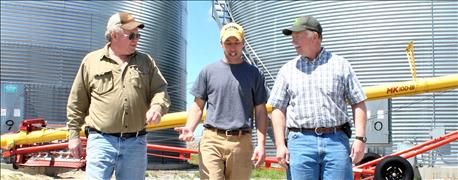
Tighter economic conditions will require a new examination of what iron is in your shed and how much it's impacting your bottom line.
Mark Hanna, Extension agricultural engineer at Iowa State University, says with each machinery need, these questions should be asked: Why do I need it? What do I want it to do? And what are the objectives for this tractor, combine or implement?
Related: Ag equipment sales to continue slide
Hanna says with machinery purchases one can easily be distracted with different options. Consider if the options add value to your specific needs and focus on what the true needs are and go from there.

Missouri farmer Mark Nuelle (left) saves money through an equipment and grain storage partnership with neighboring farmers Garrett Riekhof and Kevin Schemmer.
Kelvin Leibold, ISU farm and ag business management specialist, adds the days of tractors holding their value over time may no longer be true. An evaluation of what value some pieces of equipment bring to the operation will be needed.
Leibold notes some farmers may need to evaluate what their goals are for the next two, five and 10 years. Downsizing acres could allow farmers to hold on to more working capital even though the fixed costs are spread out over fewer acres. If you're renting ground that results in $100 cash losses per year for a year or two followed by several years of small margins, maybe it's better to let a neighbor farm that land than you straining your balance sheet, he says. But those producers who have positive cash flow may be able to obtain discounted machinery at auctions this winter.
We talked to a handful of farmers to hear how they're managing equipment costs. Here's what works for them.
1. Renting saves money
Mark Nuelle, who farms 3,000 acres of corn and soybeans in Higginsville, Mo., says for the past few years he's rented a tractor to help with spring and fall work. This allows him to do spring tillage work with one tractor without having to unhook a planter.
The $5,000 to $6,000 per year to rent is much more manageable than the $12,000 to $20,000 on payments. "Renting leaves a lot more money in my pocket. I'm not building any equity, but when figuring my bottom line, I'm ahead, especially now that things got a lot tighter than they used to be."
~~~PAGE_BREAK_HERE~~~
2. Extend machinery life
Tim Alexander, who farms 4,000 acres of popcorn, non-GMO waxy corn and soybeans in northwest Indiana near Winamac, decided to put off trading combines for one or possibly two years. "We normally trade when the combine nears 1,000 separator hours, but last winter we opted to rebuild the rotor-concave and run it longer," he says of his 2012 Case 8230. "We will have the combine paid off after this year. And by rebuilding, it should run problem-free with lower depreciation of an older machine, giving us a lower cost per acre, hopefully," he says.
3. Look for deals
Alexander also thought about upgrading and trading an older tractor, but opted to keep it at least another year, with the hope of trading for a fewer-hour tractor at a lower price due to the expected large inventory and low demand for tractors. "We always buy used tractors with lower hours because the annual depreciation is so high the first couple years on new," he says.
Hanna says the Internet has made the used machinery marketplace more competitive, allowing for easy comparisons across state lines. By seeing what's available out there, farmers may purchase something 200 miles away, but can also better negotiate with someone locally.
Leibold notes before purchasing used equipment, visiting with the mechanic at your dealership can also help you determine what unique issues may occur with that particular piece of equipment.
4. Knowledgeable employees
Leibold says if you're spending $15,000 for a tune-up, and spreading it over 2,000 acres, it gets maintenance costs down to $7 per acre. Working with your dealership and gaining knowledge about critical wear points and key maintenance items can help with maintenance costs.
Douglas Opland, who farms 10,000 acres in Des Lacs, N.D., with his brother and two nephews has been blessed with two of them having strong mechanic experience. One of his nephews was previously a mechanic at the local John Deere dealership. To help improve profits, they do most of their maintenance themselves.
With shop rates at dealerships increasing to $150 per hour, it doesn't take long for $50,000 in labor costs to add up. Opland says they likely will save $50,000 to $100,000 a year on doing their own repairs.
~~~PAGE_BREAK_HERE~~~
5. Partnerships
Leibold says custom farming can significantly drive down fixed overhead costs and allow machinery owners to spread them over more acres. It may also allow the producer who hires someone to utilize the new technology at a lower cost. Joint ownership is also an option for producers, but both entities need to evaluate its pros and cons. Nuelle has a partnership with two other farmers in a limited liability company, focusing on equipment and grain storage.
Related: Ag equipment partnership helps farmers find common ground
The agreement has big advantages in timeliness, quality control and lower costs. But the approach does take more thought and management compared to an individual operation. The farmers meet regularly to hash over spreadsheets and equipment use. They believe good communication is a must, "so that everyone knows what is going on," says Nuelle. He and his partners bought a self-propelled sprayer after comparing yield losses from poor weed control timeliness using custom spraying.
Leibold warns, "Two weak links together don't make a strong chain." It does offer opportunities to manage technology costs and some of the upfront investments by having joint ownership.
For more on buying used equipment, see this Iowa State Extension resource.
About the Author(s)
You May Also Like






